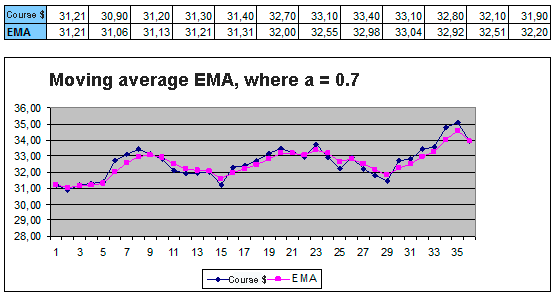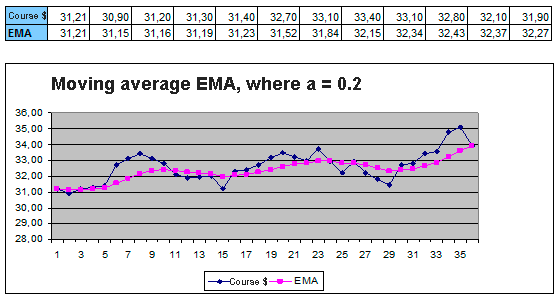Sales plan. Models of moving averages in Budget-Plan Express
In the "Budget-Plan Express" three most common moving average models and their modifications are used: SMA (simple moving average), WMA (weighted moving average) and EMA (exponentially weighted moving average).
To modify the price range, any of the 3 models (SMA, WMA and EMA) can be selected, depending on the type of calculations and data. For example, when calculating a WMA model, the row number of a row element or an adjacent series indicator (for example, sales volume) can be selected as weights.
Budget-Plan Express is a software product for preparing business plans and presentations in Word and Excel format, optimal for small businesses and studies (for students, graduate students, MBI students, etc.)
Build a financial model, calculate the options for sales plans of any complexity yourself! Try the new version of the program (6.02). Details ...
1. Simple moving average (SMA) calculated by the formula:
-
SMAt = ( Pt + Pt-1 + Pt-2 +… Pt-n+1 ) / n
where
SMAt – value of the moving average at point t;
n – number of series values, or smoothing interval.
2. Weighted moving average (WMA) is calculated according to the formula:
-
WMAt = ( Wn*Pt + W(n-1)*Pt-1 + W(n-2)*Pt-2 +… W(n-i+1)*Pt-n+1 ) / [n + (n-1) + (n-2)…(n-n+1)]
where
WMAt – value of the moving average at point t;
n – number of values of the original series;
Wi – weight of suspended component.
In fact WMA is a modification of SMA with the addition of weight components.
3. Exponential moving average (EMA) is calculated by the formula:
-
EMAt = a * Pt + (1 – a) * EMAt-1
where
EMAt – value of the moving average at point t;
EMAt-1 – value of the moving average at point t-1;
a – smoothing constant for EMA (smoothing constant), the coefficient of altering the degree of smoothing, sometimes called the coefficient which determines the rate of decrease of the weights, it takes the value from 0 to 1 (a ≠ 0).
Smoothing series and forecasting, apply the same formula, with the difference that in the first case, the calculation period for SMAt is the average period, in the second he is the last, i.e. in the case of the prediction calculation based on previous periods.
Moving averages and short term forecasts in the framework of the adaptive model
Moving averages are usually used with time series data to smooth short-term fluctuations and highlight major trends or cycles.
Extrapolation of trends as a method of forecasting is the basis of most forecasting methods, including in adaptive models based on moving averages with a short forecast interval. In the "Budget-Plan Express" no more than 3 forecast periods. The default is one period.
Adaptive methods allow, when studying the trend, to take into account the degree of influence of the previous levels on the subsequent values of the dynamic series. Adaptive methods include methods of sliding and exponential averages, the method of harmonic weights, methods of autoregressive transformations.
1. Defining an interval of smoothing
The definition of the interval of smoothing (the number of levels included in it) depends on the task:
- if it is necessary to smooth out random fluctuations, then the interval of smoothing is, as a rule, large (the maximum number of levels is "6"),;
- If there is a need to keep periodically repeating fluctuations, then the smoothing interval is reduced to 3 levels.
 The default setting is "3".
The default setting is "3".
2. Algorithm for computing with smoothing
Smoothing by a moving average is that average calculated level of 3, 4, etc. intervals. As a result, the calculation of the average as if "slips" from the beginning of the series to the end. In models of SMA and WMA, and their modifications, the degree of smoothing is determined by step – the larger the step, the higher the degree of smoothing.
In the EMA:
- At an odd step, each calculated moving average corresponds to the real interval (moment) of time that is in the middle of the step (interval), and the number of smoothed levels is less than the original number of levels by the step size of the moving average, reduced by one.
- With an even step, the two moving averages are centered. The centering operation consists in re-sliding with a step equal to two. The number of levels of the smoothed series will be less by the step size of the moving average.
Example.
Let the interval is "4". The calculation for the element "3" is the following:
| № | Row | Formula | Preliminary calculation | Final calculation |
| 1 | 20,00 | |||
| 2 | 21,00 | |||
| 3 | 19,00 | SMAt = (Pt-2+Pt-1+Pt+ Pt+1) / n |
(20+21+19+24)/4=21 | (21+22,5)/2=21,75 |
| 4 | 24,00 | SMAt+1=(Pt-1+Pt+Pt+1+ Pt+2) / n |
(21+19+24+26)/4=22,5 | 26,00 |
| 5 | 20,00 |
Then, a more convenient formula for implementing the algorithm:
-
SMAt = ½ *(Pt-2+2*(Pt-1+Pt+Pt+1) + Pt+2) / 4
Where:
SMAt – value of the simple moving average at the point t;
n = 4 – smoothing interval.
When it comes to smoothing the series, the first and last values remain unchanged, the values between the first and last periods are modified.
Construction of moving averages and extrapolation


From the graph (Example 1), if you select constant smoothing = 1, the original series and the estimated (EMA) will practically coincide.
When constructing moving averages and extrapolation of trends (short-term forecasts) are used and other periods earlier than the current with a preset interval. Here, the choice of the interval of smoothing you need to understand two "power" medium: sensitivity to changes and muting changes (fluctuations). Accordingly, if you need to increase the sensitivity of the trend interval must be shorter, and Vice versa... For EMA the sensitivity depends on the coefficient "a": a → 1, EMAt → tends to the values of the original series, and Vice versa: when you a → 0, EMAt → tends to the midline of the series.
Example 1.
Smoothing a number of moving average EMA, with a coefficient of the number "a" equal to "0.7":

Example 2.
Smoothing a number of moving average EMA, with a coefficient of the number "a" equal to "0.2":

